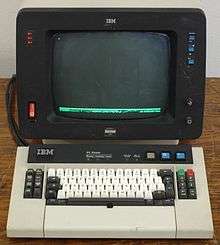Block-oriented terminal

A block-oriented terminal or block mode terminal is a type of computer terminal that communicates with its host in blocks of data, as opposed to a character-oriented terminal that communicates with its host one character at a time. The IBM 3270 is perhaps the most familiar implementation of a block-oriented terminal, but most mainframe computer manufacturers and several other companies produced them.
In a typical application the host sends the terminal a preformatted panel containing both static data and fields into which data may be entered. The terminal operator keys data, such as updates in a database entry (or the device's buffer - 3270), into the appropriate fields. When entry is complete (or ENTER or PF key pressed on 3270's), a block of data, usually just the data entered by the operator (modified data), is sent to the host in one transmission. The 3270 terminal buffer (at the device) could be updated on a single character basis, if necessary, because of the existence of a "set buffer address order" (SBA), that usually preceded any data to be written/overwritten within the buffer. A complete buffer could also be read or replaced using the READ BUFFER command or WRITE Command (unformatted or formatted in the case of the 3270).
Block-oriented terminals have the advantage of causing less system load on the host and less network traffic than character-oriented terminals. On a multi-drop line there is considerable overhead for each transmission which is the same for a single character as for thousands of characters. Block-oriented terminals may also appear more responsive to the user, especially over slow connections, since editing within a field is done locally on the terminal itself rather than depending on echoing from the host system.
Early terminals had limited editing capabilities – 3270 terminals, for example, only offered the ability to check data entered into a field defined as numeric.[1] Later so-called "smart" or "intelligent" terminals incorporated microprocessors and supported more local processing.
Common block oriented terminals
- IBM 2260
- IBM 3270
- IBM 5250
- Burroughs Corporation TD-830
- AT&T Dataspeed 40 (3270 clone manufactured by Teletype Corporation)
- TeleVideo 912,920, 925, 950[2]
- Tandem Computers VT6530
- Hewlett-Packard VT2640[3]
- UNIVAC Uniscope series
- Digital Equipment Corporation VT61, VT62
- Lear Siegler ADM31[4] (optional)
- Honeywell VIP 7700/7760
- ITT Corporation Courier line
- Bull Questar
See also
References
| Wikimedia Commons has media related to Data terminals. |
- ↑ IBM Corporation (1972). IBM 3270 Information Display System Component Description (PDF).
- ↑ "Already over 80,000 winners out there! (advertisement)". Computerworld. January 18, 1982. Retrieved November 27, 2012.
- ↑ "HP 3000s, IBM CPUs Get On-Line Link". Computerworld. March 24, 1980. Retrieved November 27, 2012.
- ↑ Lear Siegler Inc. "The ADM-31. A terminal far too smart to be considered Dumb" (PDF). Retrieved November 27, 2012.